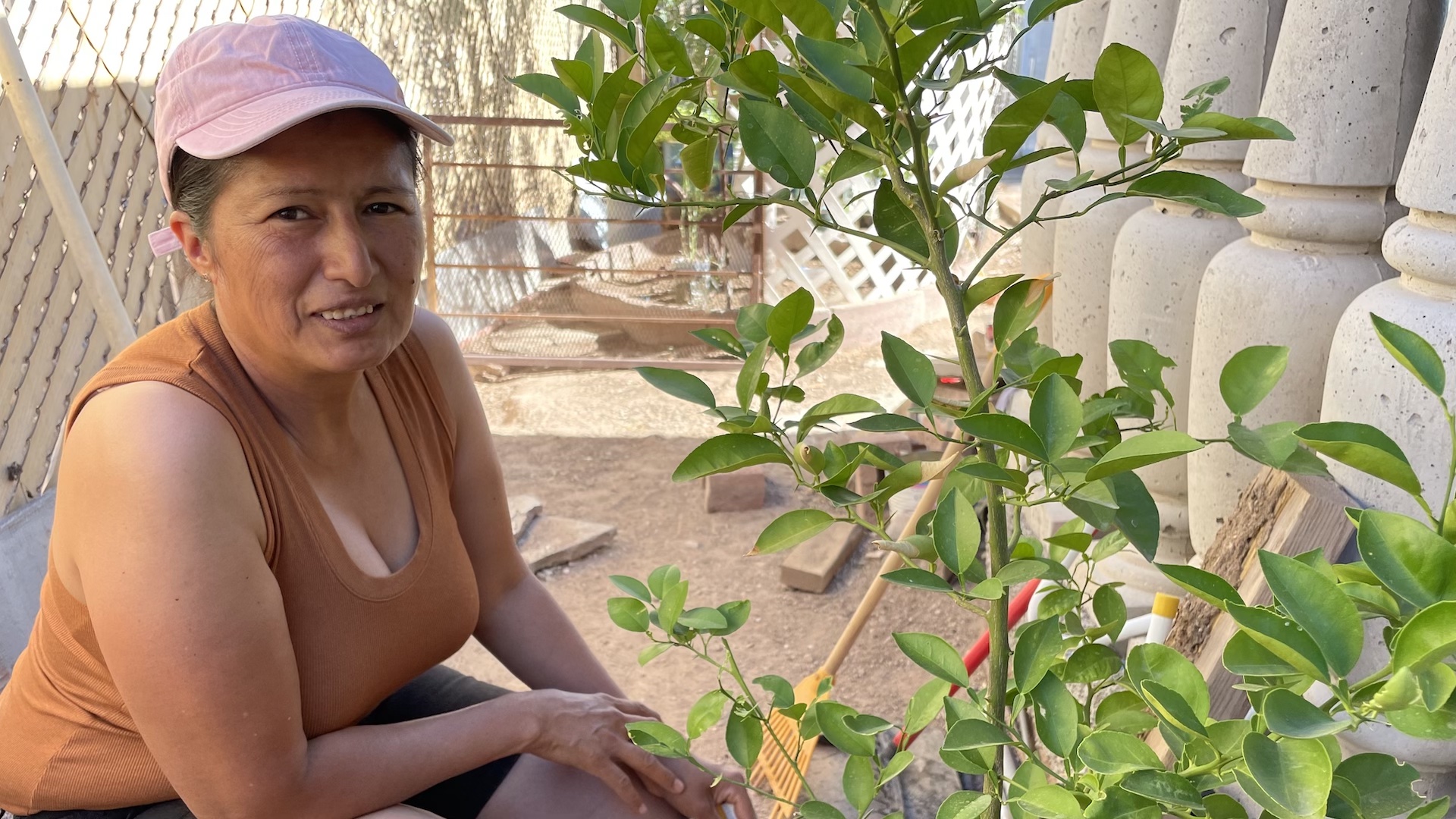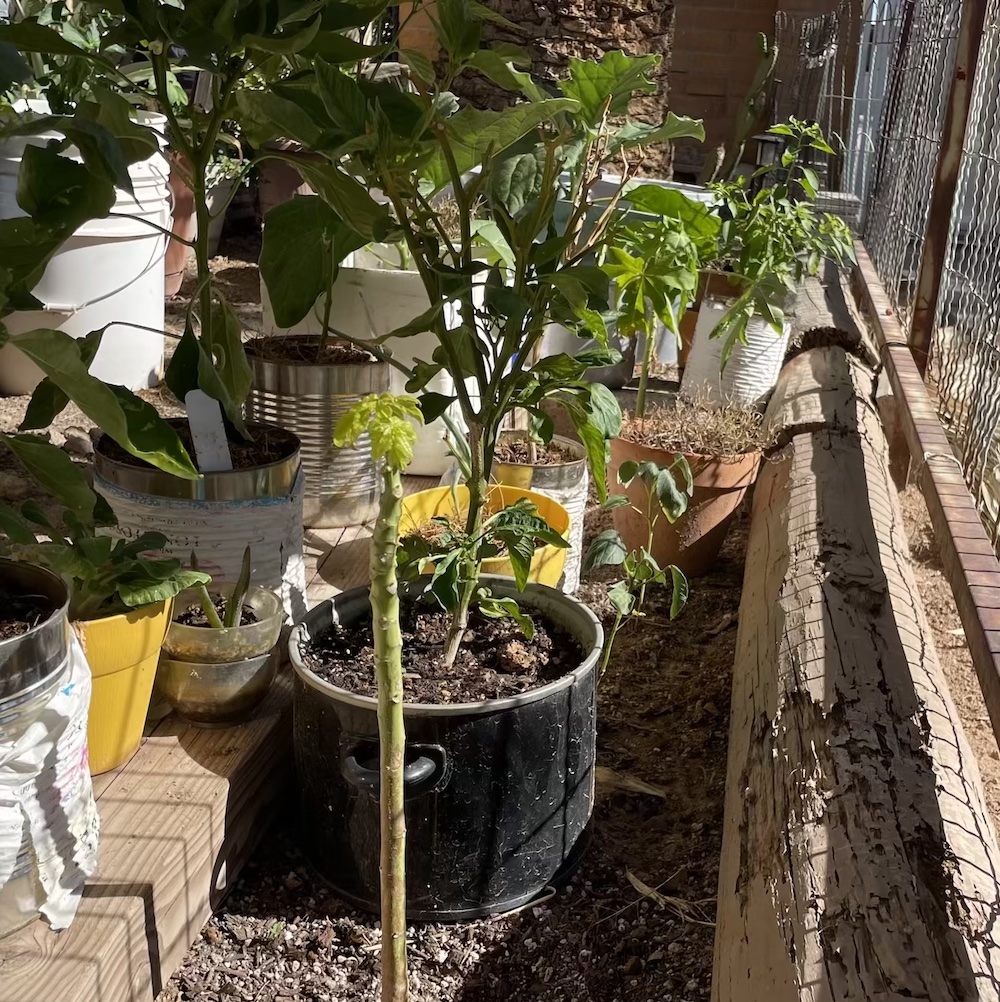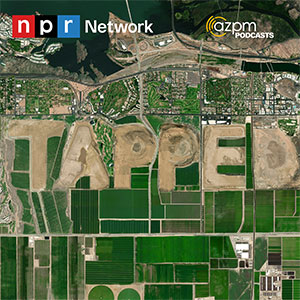 Raquel Fregoso in her Tucson garden. The organization SERI installed her rainwater harvesting system, which includes a big, green cistern on the side of her house.
Raquel Fregoso in her Tucson garden. The organization SERI installed her rainwater harvesting system, which includes a big, green cistern on the side of her house.
Strong sense of place

Tucson has a very particular look to it. You can drive from the center of town to the surrounding cities, and most of the front yards you’ll see have saguaros, prickly pears, gravel and stone.
It’s dusty, and many of the homes are made to stay cool with adobe or brick.
Courtney Crosson is an architect turned researcher at the University of Arizona, and she has lived in Tucson for five years.
“The amazing thing about Tucson is, when you get off a plane—step out of the airport—you feel like you're home because it has a very strong sense of place,” she said.
“There's no other place I could be than Tucson. That's how I feel it in my bones.”
It really looks like a desert city, even for desert cities, and there’s a really big difference between Tucson homes and homes in the rest of the country: most Tucson homes don’t have grass.
You’ll remember last time, we went to the Sweetwater Wetlands to meet Fernando Molina. He is the former head of the conservation program at Tucson Water, and he told us about how just a few decades ago, Tucson’s water wasn’t reliable. Sometimes, people even turned on their faucets, and nothing came out.
So, they upgraded the infrastructure, brought in a new water source and they asked people to use less.
“I started having to explain to people who hadn't lived here in the 70s, and in the 80s, and in the 90s–what “Beat the Peak” means,” Molina said.
“I started talking about well, you know, in the 60s and 70s, we grew and we didn't have the infrastructure to meet demands, and a voluntary program is what the mayor and council came up with. It was beating that ‘summertime peak.’”
That summertime peak is when water usage is at its highest because grass is dry and people are watering their lawns.
The typical household today in Arizona uses about 150 gallons of water every day, and the majority of that water—about 70%—goes outside to plants, pools and carwashing, among other things. And back then, that per household number was higher.
Tucson Water was struggling to keep the water on, specifically on dry, summer afternoons, so they launched a campaign asking people to stop watering their lawns in the afternoon.
In one from the 80s, a woman in a bright purple suit with shoulder pads dances and sings about watering every other day.
And in another from the 90s, mascot Pete the Beak, a duck who also made appearances in Tucson schools, wears western gear and swings a lasso.
“When people find out what I have done professionally working at Tucson Water, and I have these 30 and 40 and 50 year olds go, ‘Hey, S.W.A.S.W.A.!’” Molina said.
S.W.A.S.W.A. stands for save water and save water again. The campaign covered more ways to conserve water over the years.
“We still emphasize desert landscaping because that helps keep the peak down,” Molina said. “We emphasize a lot of our training on proper irrigation methods, because you don't want to overwater your desert plants.”
And Tucson Water has helped people change out their lawns for those desert plants. It also helps them install low-flow toilets and other means of bringing down water usage.
“I always say we ask you to do it, we teach you how to do it, we'll train you how to do it, we'll give you a financial incentive–because another financial incentive is rebates that will help subsidize the cost of buying some of these new technologies. And if none of that works, then we make you do it because there are some ordinances that mandate certain actions be taken,” he said.
At this point, there aren’t a lot of grass lawns left in Tucson.
“I think if you were to move to Tucson, and you were in your subdivision and you put a grass lawn out there, people would kind of scratch their heads and go, ‘What are they doing?’” Molina said.
Now the push is for even more water-efficient yards, and Tucson Water and Pima County both offer training and rebates to help homeowners out with that.
But the process of putting in a cistern, moving dirt around a yard to help the water flow, collecting greywater from laundry or dishes, isn’t cheap. It usually costs between $3,500 and $6,000. Tucson Water offers up to $2,000 to help residents cover it.
If you’re a homeowner, these fixes can help you save a lot of money in the long run. But what if you can’t front the cost?
David Sanabria manages the rainwater harvesting program for limited income families for the Sonora Environmental Research Institute, or SERI. He helps people get loans and grants.
“SERI’s mission is to reach out to limited income communities and minorities in the southwest, to provide different services to improve their health, and their living conditions, and to protect the environment,” he said.
The program manages a grant from Tucson Water.
“That's helped us to offer a grant up to $750. And a loan that is a zero interest loan for whatever cannot be covered between the grant and the Tucson Water rebate,” he said.
SERI helps bridge the gap for residents who want the benefits of an efficient yard–whether it’s smaller water bills, shade from trees, fresh fruit–but can’t afford it.
They also do a lot of work to get the word out.
“A lot of the population the organization works with, they don't have access all the time to the internet, or to technology. And because of that, it's hard for them to just go to a website, find all the information and get access to these services,” Sanabria said.
So he and his colleagues go door-to-door to tell people about it. They also advertise it over social media.
Sanabria said SERI has installed over 200 cisterns, more than 200 gutters and 90 passive systems. They’ve also awarded over 250 grants and about 150 loans.
He took me to visit a client at her house.
Raquel Fregoso lives in Tucson, and on that day, she and David were making a plan to bring shade to a corner of her yard that gets too much sun to do much of anything with.
“Gardening, growing food isn’t my job and it's not something I would have sought out. But I still like to do it, and I try to cook as healthy as possible,” she said.
She also said she likes to do it because she likes to eat good food. And when she’s in her garden, she’ll pull the leaf of an herb and taste it.
She showed me a citrus tree.
“ I don’t know what it is, but the small leaves mean it could be a lemon tree,” she said.
She tried a leaf and then offered one to me. It tasted a little sour.
“I’ll go to a restaurant and get pretty much the same flavor that I would’ve if I’d cooked myself. Sometimes, I even like what I cook better,” Fregoso said.
 VIEW LARGER Fregoso has 11 chickens and a rooster in her garden.
VIEW LARGER Fregoso has 11 chickens and a rooster in her garden.  VIEW LARGER SERI installed Fregoso's rainwater harvesting system, which includes a big, green cistern on the side of her house, and a pipe that runs underground to the chickens.
VIEW LARGER SERI installed Fregoso's rainwater harvesting system, which includes a big, green cistern on the side of her house, and a pipe that runs underground to the chickens.  VIEW LARGER Raquel Fregoso calls her garden small, but it has fruits, vegetables, herbs and medicinal plants.
VIEW LARGER Raquel Fregoso calls her garden small, but it has fruits, vegetables, herbs and medicinal plants. She called her garden small, but it has fruits, vegetables, herbs and medicinal plants. She also got help from the food bank to buy chickens–a dozen of them.
They had a roomy chicken coop, and were roaming free. She showed me where they eat and drink.
Fregoso said she really likes having the fresh eggs.
“I want them to be happy, and that’s why I have fresh water for them, food, and I try to keep it in the shade where the sun won’t hit it, and I made them a space with loose dirt, so they can bathe there,” she said.
She’s lived in this house for over a decade, but heard about SERI just a few years ago. They came out and installed her rainwater harvesting system, which includes a big, green cistern on the side of her house, and a pipe that runs underground to the chickens.
And they keep coming back to help her keep it up and work with her on new ideas.
“I wanted to do it before because I’d heard there’s not a lot of water left here. So, I don’t want to waste tap water because I want the next generation to still have access to water,” she said.
Courtney Crosson, the architect and UA researcher, has also worked as a sustainability consultant focused on water. She said getting homeowners on board is important, but that’s not the end of it.
“The problem in Tucson is that as we densified and covered up pervious areas where rain would naturally soak into the ground, it created more and more flooding. And you see this in a lot of American cities that are densifying,” she said.
She said it’s hard to retrofit a city that’s set up this way.
“But another way that we can complement some of those bigger systems is green infrastructure, which simply means that you use vegetation, plant, soil, to absorb that stormwater, use it and buffer it,” she said.
And it doesn’t have to be prohibitively expensive for developers.
“If it's designed properly, not only am I putting in a tree but if I put a basin next to the tree, I can also start dealing with some of that stormwater as well,” she said.
And saving energy will ultimately mean saving water.
“It's much better to build up for a few different reasons. Density is helpful because density increases walkability, which means that people aren't getting in their car and burning fossil fuels,” she said.
“Density can also create a lot of efficiency, meaning when you build a house, you know, house by house by house, the amount of air conditioning or energy put into those houses is higher than if you had like a central plant and powered an apartment building.”
And she says it saves water when we mix housing and other types of buildings, like offices.
“So residential buildings have a lot of great gray water because of the showering and laundry use, you can get a lot of gray water. Office buildings–very little gray water.
“But if you put them right next to each other, and you could create a district water system, you can imagine using all that gray water to flush all the toilets in the system,” she said.
And that could put a big dent in bringing down water use.
“Everything's clean to a potable standard, which is very energy intensive,” she said. “It's also just plain wasteful of that water. If you imagine that a home is set up to use water multiple times or three times, we could cut our water use by a third or by a half.”
Crosson also said that the cost of water is too low, not just in Tucson, but across the country.
“The price of water does not actually reflect its true value in society, and unless water is priced more highly, people are just simply not going to value it and not going to put these innovations into their home,” she said.
In recent years, Tucson has won awards and been sought out by other places looking to curb water usage.
“Tucson is a great example of culture change, really successful culture change around grass lawns,” she said. “I think we live in a community that very successfully uses rock and natural adaptive vegetation and has a very beautiful way to landscape.”
And Crosson said while more of that willingness to change from residents is important, those in power and those building new homes have to do more to make Tucson a city that can weather drought.
“I do believe that the best changes that we can make are ones that are kind of that are built in, that are designed into the way that we live versus telling people, you know, take a one minute shorter shower,” she said.






By submitting your comments, you hereby give AZPM the right to post your comments and potentially use them in any other form of media operated by this institution.